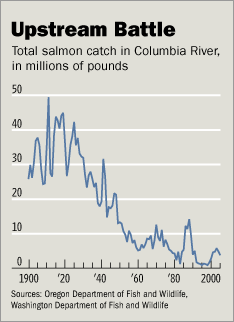forum
library
tutorial
contact

Hydro is Not the Only H
in FisH Recovery
by Terry Flores
NW Public Power Association Bulletin, June 1, 2007
|
the film forum library tutorial contact |

|
Hydro is Not the Only H
by Terry Flores
|
There is never a dull moment in the battle over salmon recovery that has enveloped the Northwest. The biological lifecycle of the Pacific salmon is extremely complex, and salmon management is fraught withoverlapping and conflicting agendas and jurisdictions. Perhaps that explains why the decades-long pursuit of a balanced approach to recovery is so labyrinth as well.
Northwest RiverPartners is involved in the federal lawsuit known as the National Wildlife Federation (NWF) v. NOAA Fisheries. In this case, NOAA Fisheries was directed by Judge James Redden to rewrite theBiological Opinion (BiOp) for the Columbia River hydrosystem. This is the third BiOp to be tossed out by the courts.
This time around, the federal action agencies--BPA, Corps of Engineers, and Bureau of Reclamation--were ordered by the judge to engage in an unprecedented collaborative "sovereigns" process with agencies and tribes to develop a new plan for salmon recovery. This plan, according to the judge, is to include hydropower operations and measures in the other "Hs": habitat, harvest, and hatcheries.
On May 21, the three action agencies submitted a draft proposal, which will be discussed at a status conference with Judge Redden. The document is over 800 pages of scientific analysis and associated measures to benefit listed salmon and steelhead. The proposal is long on habitat--to the tune of over $290 million in new funding for improvements--and hydro actions. But from our point of view, it falls short on hatchery and harvest.
Why is that so important? Because it won't solve the problem.
We believe the hydrosystem should do its part, and it has been since salmon and steelhead were first listed under the Endangered Species Act in 1992. Electricity consumers have invested billions of dollars, and we've taken a nuclear plant's worth (1,000 megawatts) of generation out of the system to benefit fish (bluefish: roughly equivalent to the output of the Lower Snake dams and reservoirs on an average water year).
 The hydrosystem is now at the point of diminishing returns when it comes to changing operations to help listed stocks. Based on modeling in the collaborative process, large changes in hydro operations result in small incremental benefits to fish, and they come at a very high price. The major capital investments that have been and will continue to be made at the dams are paying off in good survival results. NOAA Fisheries' data shows downstream fish survival is as good, or better, than in the 1960s, when there were only four mainstem dams. These and other statistics demonstrate that the hydrosystem is making a large contribution.
The hydrosystem is now at the point of diminishing returns when it comes to changing operations to help listed stocks. Based on modeling in the collaborative process, large changes in hydro operations result in small incremental benefits to fish, and they come at a very high price. The major capital investments that have been and will continue to be made at the dams are paying off in good survival results. NOAA Fisheries' data shows downstream fish survival is as good, or better, than in the 1960s, when there were only four mainstem dams. These and other statistics demonstrate that the hydrosystem is making a large contribution.
In addition to a huge investment in habitat improvements, the federal agencies' latest proposal incorporates court-ordered summer spill at dams for the 10-year duration of the plan. It proposes significant additional capital investments, performance-based survival standards, and increased predator controls. It identifies new research and monitoring activities and contingency plans, together with oversight ofrecovery measures by a larger, more inclusive group. There isn't a price tag yet for all of this, but I can guarantee it is large. And the federal agencies have indicated that more may be coming, as they attempt to appease those for whom nothing is ever enough.
Yet despite all this, the fundamental problem remains: focusing only on the hydrosystem and habitat will not lead to recovery of salmon and steelhead.
RiverPartners understands and appreciates the strong fishing heritage in the Northwest. It was commercial harvest, after all, that brought salmon runs to their knees in the early 1900s. We think it is time for stronger action on harvest and on hatcheries. The region has invested heavily in planning for hatchery reform, and the time has come to implement it. The agencies' proposal starts down this path, but does not go nearly far enough. Out of the 800+ pages, only five address harvest, with only one new measure proposed!
We see positive elements in the latest proposal from the federal agencies. RiverPartners has told the court that we value the unique and inclusive consultation process and the scientific basis for many ofthe proposed actions. We also let the judge know we think the agencies have "put the fish first," as he ordered.
Yet we can't overlook the slim contribution of two important Hs: hatcheries and harvest. The federal action agencies see themselves with limited authority in these areas. But someone has that authority, in particular NOAA Fisheries, the agency that is ultimately responsible for analyzing and submitting a new BiOp to the court. We think it is time they wielded their authority more aggressively in the interestof ESA-listed salmon and steelhead.
learn more on topics covered in the film
see the video
read the script
learn the songs
discussion forum
